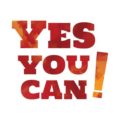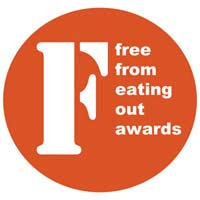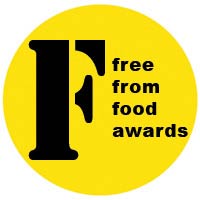We all do it, even if the best etiquette manuals say not to: using your own knife or spoon to dip out some butter or marmalade. If that knife has just spread butter on your ‘normal’ bread, and then you dip it into the marmalade – or back in the butter – the chances are high that you’ve just added some crumbs with gluten into the butter or marmalade. If the next person to take some butter happens to be gluten free, you’ve probably just given them stomach pain, diarrhoea, wind …
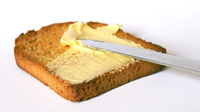
What if you cut ‘normal’ bread, and then cut cheese with the same knife? What if you stir a pan of ‘normal’ pasta, and then stir a pan of gluten free pasta with the same spoon?
Other sources of cross-contamination include toasters, grill pans, bread boards, colanders, sieves, baking trays, leaking bags of flour on supermarket shelves, scoops used in pick-and-mix sweetie counters, or in health-food stores, putting croutons on a salad and then just taking them off to make it ‘gluten-free’ (or buns on burgers, wafers in icecreams …), or even just passing some ‘normal’ bread across a bowl of gluten free soup and getting crumbs in the soup.
If someone in your house has to live gluten free, the best way to avoid this kind of problem is to make sure that they have their own pots of butter, jam, marmite, mayonnaise or whatever, clearly labelled. You then have to be sure that all visitors to the house understand the rules, too!
Lucky coeliacs have enough space in their kitchen to have a dedicated gluten free area, with their own implements, or families that all go gluten free together. Everybody else – with less space or money – has to be very vigilant, to be sure that if a spoon or knife has gone into something that contains gluten, that it goes nowhere near the gluten free foods. If you’re cooking both gluten-containing and gluten-free things in the same oven, use different baking trays. Don’t put pizza directly on the oven shelves unless you’re going to wash them afterwards (which shelf had the normal pizza on? will you remember in a week?). You can use foil to make a protective barrier between the oven shelves and the food, or on baking sheets, or to create individual ‘trays’ for cooking on.
Buy a second toaster. Have you seen the crumbs that accumulate inside a toaster? Or you can toast under the grill (remember to use that foil, though). Or, you can use Toastabags- these are great, and will protect your slice of toast from other crumbs … The strongest I’ve seen come from Lakeland Limited, but these come from Amazon (aff), and work just as well. 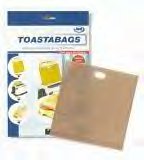
What about when you go out to eat? There is a reason why McDonalds say that coeliacs shouldn’t eat their fries if they have a special promotion on of some other gluten-containing treat – oil is easily contaminated. Tiny pieces of crumb coating or spices can float free of one item and land on another …
Just as risky is the idea that simply taking the bun off a burger, or the croutons off a salad will remove the risk of gluten contamination. Obviously that’s better than eating the bun/croutons – but there will be some crumbs left.
Lots of factory-produced items now say ‘Produced on a line [or in a factory] which also processes nuts, gluten, celery … [add in your own allergen here].’ There is a risk – probably miniscule – that gluten could be transferred from one item to another in the factory, and the manufacturers are covering themselves.
Only you can decide about whether to gamble on this last risk – and gambling with your child’s health is so much more difficult than with your own. Only you can assess how sensitive you are to gluten – and it does seem to vary from person to person.
But it does make sense to avoid cross-contamination as much as possible at home. We use:
- a gluten free cupboard for bread, flours etc
- a gluten free bread bin
- a gluten free biscuit tin
- lots of foil
- toastabags
- dedicated pots of butter and jam
- and dedicated knives at table.
 |
I’ve written a book summarising what we’ve learnt over 20 years of dealing with the gluten free diet, and it might be just what you’re looking for. It packs the lessons we’ve learned into what I hope is a helpful and straightforward guidebook. It’s available on Amazon, as a paperback or for your Kindle… |
